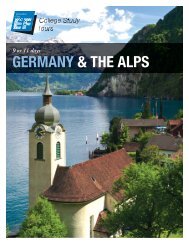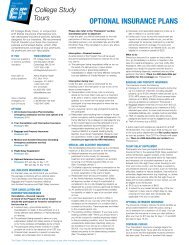View Merilyn's course syllabus (PDF) - EF College Study Tours
View Merilyn's course syllabus (PDF) - EF College Study Tours
View Merilyn's course syllabus (PDF) - EF College Study Tours
- No tags were found...
Create successful ePaper yourself
Turn your PDF publications into a flip-book with our unique Google optimized e-Paper software.
Professor: Dr. Merilyn L. Copland<br />
Course: ARCH 351/Archaeology of Egypt<br />
William Jessup University<br />
STUDIES ABROAD: EGYPT<br />
I. Course Description<br />
This <strong>course</strong> will cover selected topics on the archaeology<br />
of ancient Egypt, incorporating the latest archaeological<br />
discoveries from sites we will be visiting like the Great<br />
Pyramids, Valley of the Kings, ancient Thebes, and<br />
Alexandria. We will place the impressive monuments<br />
of this great civilization in the context of the rise and<br />
development of Egyptian civilization. How did construction<br />
of huge pyramids and majestic temples contribute to<br />
the power and authority of the Pharaohs What was the<br />
relationship between kings, nobles, and commoners<br />
What was life like along the Nile at the height of<br />
Egyptian civilization Egypt is often looked at as a static,<br />
unchanging civilization, but we will see how society and<br />
religion evolved to meet new challenges through the<br />
3,000 years of Pharaonic history. Throughout there will<br />
be an emphasis on material culture as source for the<br />
political, social, religious and economic dynamics of<br />
ancient Egypt. We will look both at the grand artifacts<br />
of kings like Tutankhamen and the simple objects of<br />
everyday life found in villages like Deir el-Medina, the<br />
community of workmen who built the tombs in the<br />
Valley of the Kings. Discussions will also focus on the<br />
major archaeological finds relating to biblical history and<br />
literature. Prerequisites: BIBL101 or Western Civilization I.<br />
II. Course Goals<br />
a. Develop a greater understanding of the Egyptian<br />
cultural, historical, and geographical background for the<br />
message of the Old and New Testaments<br />
b. Appreciate the beauty of Egyptian art, architecture, and<br />
literature<br />
c. Understand the interplay of the geography, history,<br />
religion, and archaeology of Egypt<br />
d. Think critically about the relationship between religion<br />
and values in a culture<br />
e. Develop an appreciation of the diversity of cultures in<br />
Egypt today<br />
f. Appreciate the infuence of Egyptian literature on wisdom<br />
literature in the Old Testament<br />
g. Increase the student’s desire to re-read the Bible with<br />
Egyptian history and archaeology as a background<br />
III. Course Outcomes<br />
At the end of the semester the student should be able to:<br />
a. Articulate the significance of reading historical and<br />
biblical texts in light of their social, historical, literary,<br />
and archaeological contexts.<br />
b. Define important terms used in Egyptian archaeology<br />
c. Demonstrate in writing knowledge of Egyptian culture,<br />
art, religious practices, and society known from ancient<br />
remains<br />
d. Identify the most important discoveries in Egypt relating<br />
to the Old and New Testament<br />
e. Integrate archaeological information into contextual<br />
studies for understanding of Egyptian and biblical texts<br />
IV. Course Requirements<br />
a. Read the assigned text and website articles according<br />
to the <strong>course</strong> schedule and be prepared for class<br />
discussion about the content<br />
b. Keep a daily journal during the trip. The journal should<br />
include observations about the geography, climate,<br />
sites, artifacts, and life-ways of the current population<br />
in the areas visited. Your journal may include a photo<br />
essay with text, slides for a visual presentation to a<br />
group, or a video essay. The journal is due on or before<br />
Feb. 15<br />
c. Make a timeline of historical periods of Egypt from<br />
Pre-Dynastic through the Roman period. The timeline<br />
should include major buildings or monuments, names<br />
of important pharaohs, illustrations of objects typical of<br />
efcollegestudytours.com | 800-873-2250
the period, artistic or literary developments. Also noted<br />
should be points of intersection with biblical narratives<br />
(e.g. Joseph, Moses, Jeremiah’s exile, Jesus). The<br />
timeline is due on or before Mar. 15<br />
d. Select a topic of interest with respect to architecture,<br />
art, history, literature, or any other area of a specific<br />
period in ancient Egypt to research. The paper should<br />
be from four to six pages with a bibliography of works<br />
cited. The paper is due on or before April 15<br />
V. Textbooks<br />
Required:<br />
Ian Shaw, Ancient Egypt: A Very Short Introduction<br />
(Oxford University Press, 2004) ISBN-10: 0192854194 or<br />
ISBN-13: 978-0192854193<br />
John Currid, Egypt and the Old Testament (Baker Books,<br />
1997) ISBN 0-8010-2137-5<br />
John Romer, Ancient Lives: Daily Life in Egypt of the<br />
Pharaohs (New York: Henry Holt, 1984) ISBN 0-8-50-<br />
1244-3<br />
Recommended:<br />
Kathryn Bard, Introduction to the Archaeology of Ancient<br />
Egypt (Wiley, 2007) ISBN 10: 1405111488 or ISBN-13: 978-<br />
1405111485 (Brand new hardback but expensive; not yet<br />
available in paperback)<br />
Douglas Brewer and Emily Teeter, Egypt and the Egyptians<br />
(2nd ed., Cambridge, 2007) ISBN-10: 0521616891 or<br />
ISBN-13: 978-0521616898<br />
VI: Course Schedule<br />
The Egypt preview night will cover the introduction to the<br />
<strong>course</strong>, the <strong>syllabus</strong>, policies, and resources. If you have<br />
not had any previous <strong>course</strong>work in or formal exposure to<br />
archaeology, you will find it useful to browse any of Brian<br />
Fagan’s college textbooks on archaeology, particularly his<br />
In the Beginning.<br />
Day 1: Departure<br />
Before departure, look at and print the satellite map of<br />
Egypt so that you will be familiar with the topography of<br />
Egypt before you arrive. Download the map from uta.edu/<br />
anthropology/petruso/egypt05env.htm. Also become<br />
familiar with the sequence and dates of Egyptian periods<br />
of history from the handout.<br />
Day 2: Arrival in Cairo<br />
As we approach Cairo, look out the window and try to<br />
spot as many topographical features as you can from your<br />
map. Note what areas are densely populated and figure<br />
out what the reasons are for the distribution of people.<br />
Welcome to one of the most exotic capitals in the world.<br />
Transfer to the hotel.<br />
Day 3: Cairo<br />
We begin with the ultimate site, one of the Seven Wonders<br />
of the World, the Pyramids of Giza (Cheops, Khafre, and<br />
Menkaure). We will also visit the Sphinx and the entire<br />
funerary complex. Afterwards we will drive to Saqqara<br />
to see the oldest pyramid, the Step Pyramid of Djoser.<br />
Nearby Memphis was the capital of Egypt during the<br />
Old and Middle Kingdoms; it would have been here that<br />
Joseph managed the grain storage and distribution for the<br />
pharaoh. Happy New Year’s Eve!<br />
Day 4: Cairo<br />
Visit the Egyptian Museum and Old Cairo with its Coptic<br />
church and architecture. If possible we will visit the<br />
famous Ben Ezra Synagogue where the Cairo Geniza Old<br />
Testament manuscripts were found.<br />
Day 5: Aswan and Elephantine Island<br />
Fly to Aswan for the start of the Nile cruise. Tour the<br />
Aswan Dam, the Temple of Isis at Philae and the<br />
Unfinished Obelisk, once intended to be the largest<br />
structure of worked stone in the world. Take a delightful<br />
felucca (traditional Egyptian sailing boat) past Elephantine<br />
Island where the Elephantine Papyri and remains of a<br />
Jewish community were found.<br />
Day 6: Kom Ombo and Edfu<br />
Sail in a felucca to Kom Ombo to see the Temple of<br />
Sobek, the crocodile god. Then back on the boat to go<br />
to Edfu.<br />
Day 7: Esna<br />
We will visit the well-preserved Temple of Horus at Edfu<br />
before sailing on to Esna to visit the Temple on Khnum.<br />
Evening sail to Luxor.<br />
Day 8: Luxor and Karnak<br />
Today we visit the ancient city of Thebes with the huge<br />
complexes of temples at Luxor and Karnak. You may wish<br />
to attend the Sound and Light performance in the evening.<br />
Day 9: Valleys of the Kings and Queens<br />
The pharaohs of the New Kingdom were buried like the<br />
sun on the west bank of the Nile. We will see Valley of the<br />
Kings, going into one or more of the tombs before going<br />
on to the Valley of the Queens. The reading in Romer’s<br />
Daily Lives are based on the finds at Deir el-Medina, the<br />
village of the men and their families who worked on the<br />
tombs of the pharaohs, queens, and nobles. The tour of<br />
the funerary complex of Hatshepsut at Deir el-Bahri is<br />
important for her possible identification with the pharaoh’s<br />
daughter who adopted Moses. The Ramasseum with<br />
reliefs celebrating the Egyptians’ defeat of the Sea<br />
Peoples including the Philistines. A brief visit to the<br />
Colossus of Memnon will be our last before boarding the<br />
night train from Luxor to Cairo.<br />
Day 10: Cairo and the Egyptian Museum<br />
Arrive in Cairo and take a tour of the Citadel and the<br />
Egyptian Museum. There will be free time in the afternoon<br />
for shopping or people-watching.<br />
efcollegestudytours.com | 800-873-2250
















